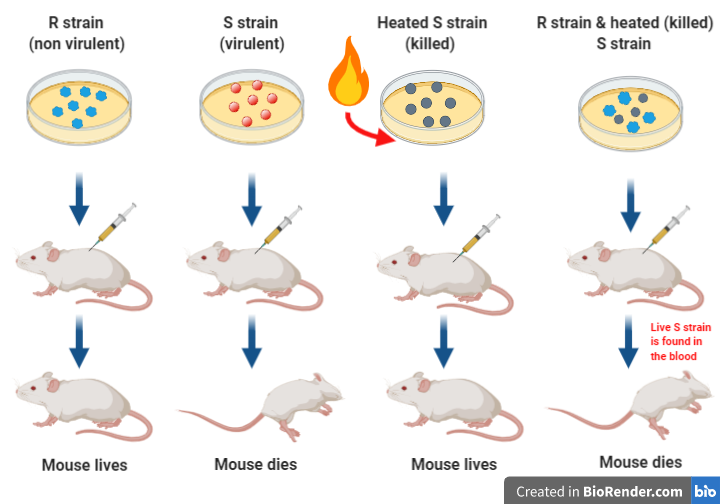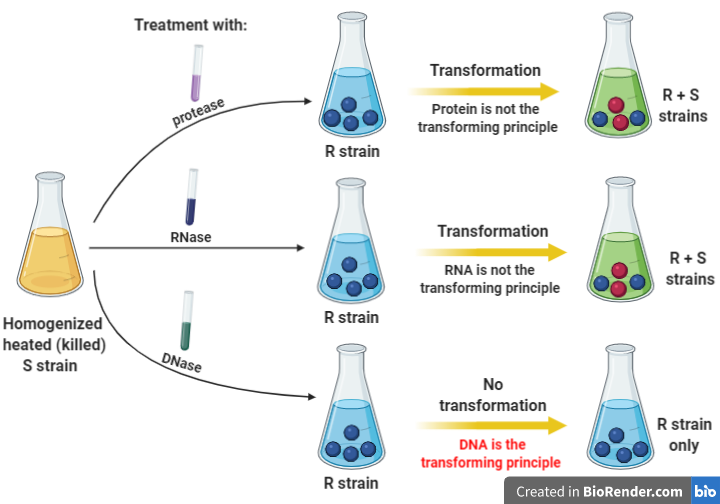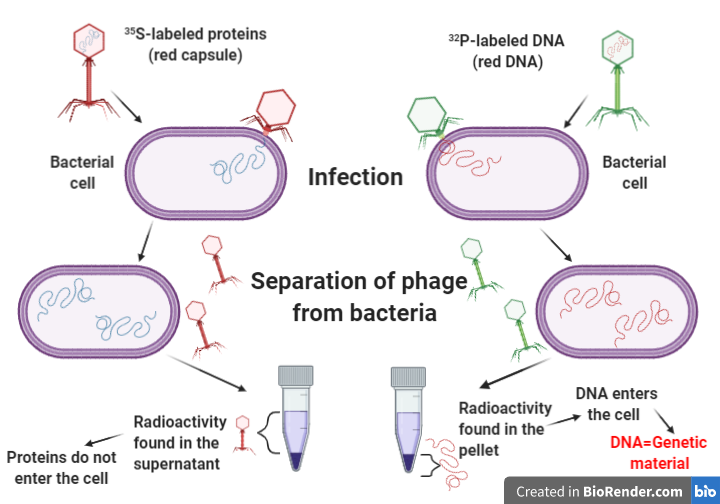In a previous post, we learned that DNA is the genetic material of the cells, and one of its most important functions is that it contains genes that carry the information for the determination of the hereditary characteristics. However, scientists were not always aware that DNA was the genetic material. In fact, for the first half of the 20th century, there was no definitive answer, and many scientists were claiming that proteins were the genetic material.
Are proteins the genetic material?
Not having any evidence proving otherwise, it was quite logical for them to think that proteins were the molecules carrying our genes, mainly because of their structure and complexity. Researchers were already aware that proteins consisted of different combinations of 20 amino acids, whereas DNA only used 4 nucleotides. Therefore, they considered that proteins could form more diverse molecules, able to carry the genetic information for all the features and functions of an organism. As we will see in the following paragraphs, though, some carefully organized experiments would turn out to be the foundation of the science of biology as we know it today, by providing solid proof that DNA is the genetic material.
Griffith’s experiment
In 1928, Frederick Griffith conducted an experiment that contributed to the discovery of DNA as the genetic material, even though this was not what he was searching for. Griffith was trying to develop a vaccine against bacterial pneumonia. He used two different strains of the bacterium Streptococcus pneumoniae, which were called R and S strains deriving from the terms rough and smooth, respectively. These two strains presented both morphological and functional differences. The S strain formed round and smooth colonies due to the presence of a sugar coat or capsule on the cell surface. This capsule protected the bacteria from being identified by the immune system of the organisms, and therefore, allowing them to cause disease. On the other hand, the R strain bacteria formed colonies that appeared rough because they did not have that capsule. This absence made them susceptible to the immune system, which recognized and destroyed them, and thus they did not cause disease. Griffith studied these two strains by injecting them in mice.
- When he injected mice with the virulent S strain, the mice developed pneumonia and died.
- When he injected mice with the non-virulent R strain, the mice survived.
- He then killed S bacteria with heat (high temperature kills the cells) and injected them in the mice. Since the bacteria were dead, they could not cause disease, and the mice survived.
- Finally, he combined heated-killed S bacteria with living, non-virulent R bacteria and injected them in mice simultaneously. The results of this injection were quite surprising. The mice developed pneumonia and died, and when Griffith took a blood sample from the dead mice to examine, he noticed that inside the blood, there were living S bacteria.

How was that possible? He had not infected the mice with living S bacteria, but living S bacteria were present in the blood and were the reason for their demise. Griffith thought that some kind of “transforming principle” was transferred from the killed S bacteria to the living R bacteria and transformed them into virulent S bacteria since they could now form a capsule, avoid the immune system and cause the disease.
Griffith did not find what kind of molecule this transforming principle was, but he knew it was the genetic material, containing a gene responsible for the capsule formation. He might not have found the answer to the question of what the genetic material is, but his results inspired the following experiment.
Avery-MacLeod-McCarty experiment
Three researchers, Oswald Avery, Maclyn McCarty, and Colin MacLeod started a series of experiments to uncover the identity of the transforming principle in Griffith’s experiment. After many steps, they found the answer in 1944. They prepared cultures of S bacteria, which they killed with heat as Griffith had done in his experiment. Then, they tried to purify the transforming factor from the other molecules that are present in the cells by removing or destroying these other molecules step by step.
In order to find out if proteins were the genetic material, they added proteases to the solution, which are enzymes that degrade (destroy) proteins. Afterward, they mixed the solution with living R bacteria and found out that some of the R cells were transformed into virulent S cells, the same thing that happened in Griffith’s experiment. What did this finding mean? With the S cell proteins destroyed, transformation still took place. Therefore, proteins are not the genetic material that carries the genes.
The researchers were left with the two nucleic acids: RNA and DNA. When they used RNases, enzymes that destroy the RNA molecules, and added the R bacteria, the transformation occurred once again, proving that RNA is not the transforming principle. Finally, they used DNase, a DNA destroying enzyme, and mixed the solution with R bacteria. No living S bacteria were found, proving that no transformation occurred in the absence of DNA, and consequently, that DNA is the genetic material.

Despite these findings, many scientists were reluctant to accept that DNA is the genetic material, pointing out that a substance could be still contaminating the experiment, making the researchers believe that DNA is the genetic material. But the final answer to these questions came a few years later with another experiment.
Hershey and Chase experiment
In 1952, Alfred Hershey and Martha Chase investigated whether DNA or protein is the genetic material in a series of experiments with the use of bacteriophages and bacteria. A bacteriophage or phage is a type of virus that attacks bacteria and has a characteristic structure and mode of action. Proteins are found on the exterior of the viral particle, while DNA is stored on the inside. The phage attaches to the bacterial surface and injects something (the genetic material) into the cell, transferring the information that’s needed for the replication of the virus. Scientists, though, did not know whether this was DNA or proteins. In order to identify which substance it was, they divided the phages into two groups and treated them differently.
- In the first group, they labeled the phages with a radioactive isotope of sulfur, 35S. Since S is found in proteins but not in DNA, only the phage proteins were labeled in this group.
- In the second group, they treated the phages with a radioactive isotope of phosphorous, 32P. Since P is present in DNA but absent from proteins, only the phage DNA was labeled in this group.
Then they used these two groups of labeled phages to infect two groups of E.coli cultures. A process called centrifugation followed, during which they separated the bacterial cells from the phage parts that did not enter the bacteria. Due to their different weight, cells moved to the bottom of the tube, forming a pellet while all the other materials, including the phage parts, remained at the top of the tube, above the pellet, forming a layer called the supernatant.

In the first group of the experiment, radioactivity was measured in the supernatant, indicating that the 35S-labeled proteins did not enter the bacterial cells, and therefore, ended up in the supernatant. In the second group, radioactivity was measured in the pellet, meaning that the 32P-labeled DNA of the phages entered the bacterial cells and thus ended up in the pellet. These results prove that the molecule carrying the information for the viral replication inside the bacterial cells is the DNA, meaning that it is the phage’s genetic material. The results of the Hershey-Chase experiment were widely accepted, and DNA was recognized as the genetic material.
If you want to watch quick videos explaining these experiments, go to:
https://www.youtube.com/watch?v=ARHrYr_SqHs&ab_channel=QuickBiochemistryBasics https://www.youtube.com/watch?v=N72Cle8xST0&ab_channel=QuickBiochemistryBasics https://www.youtube.com/watch?v=GwOu-3kZ5tk&ab_channel=QuickBiochemistryBasics
